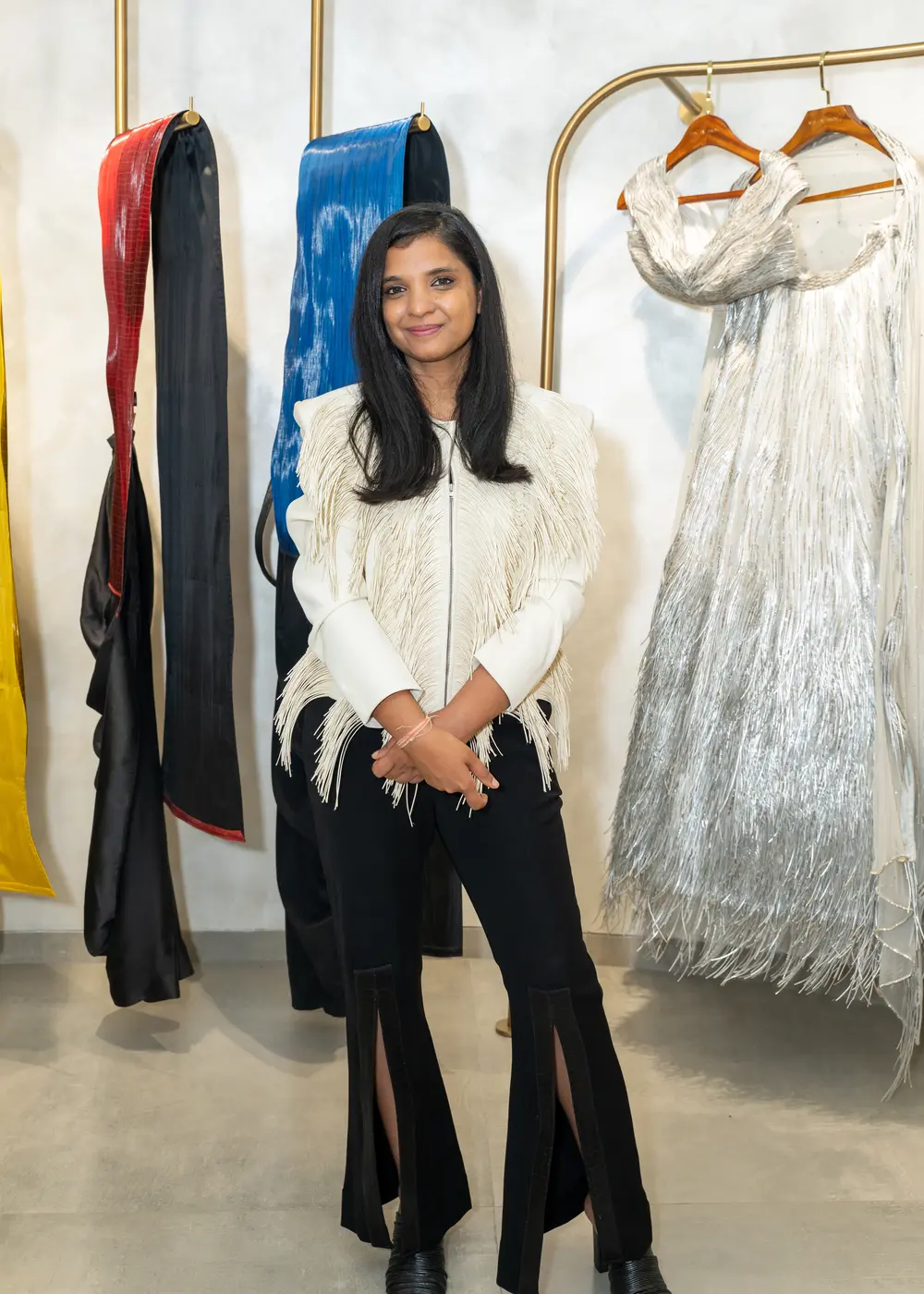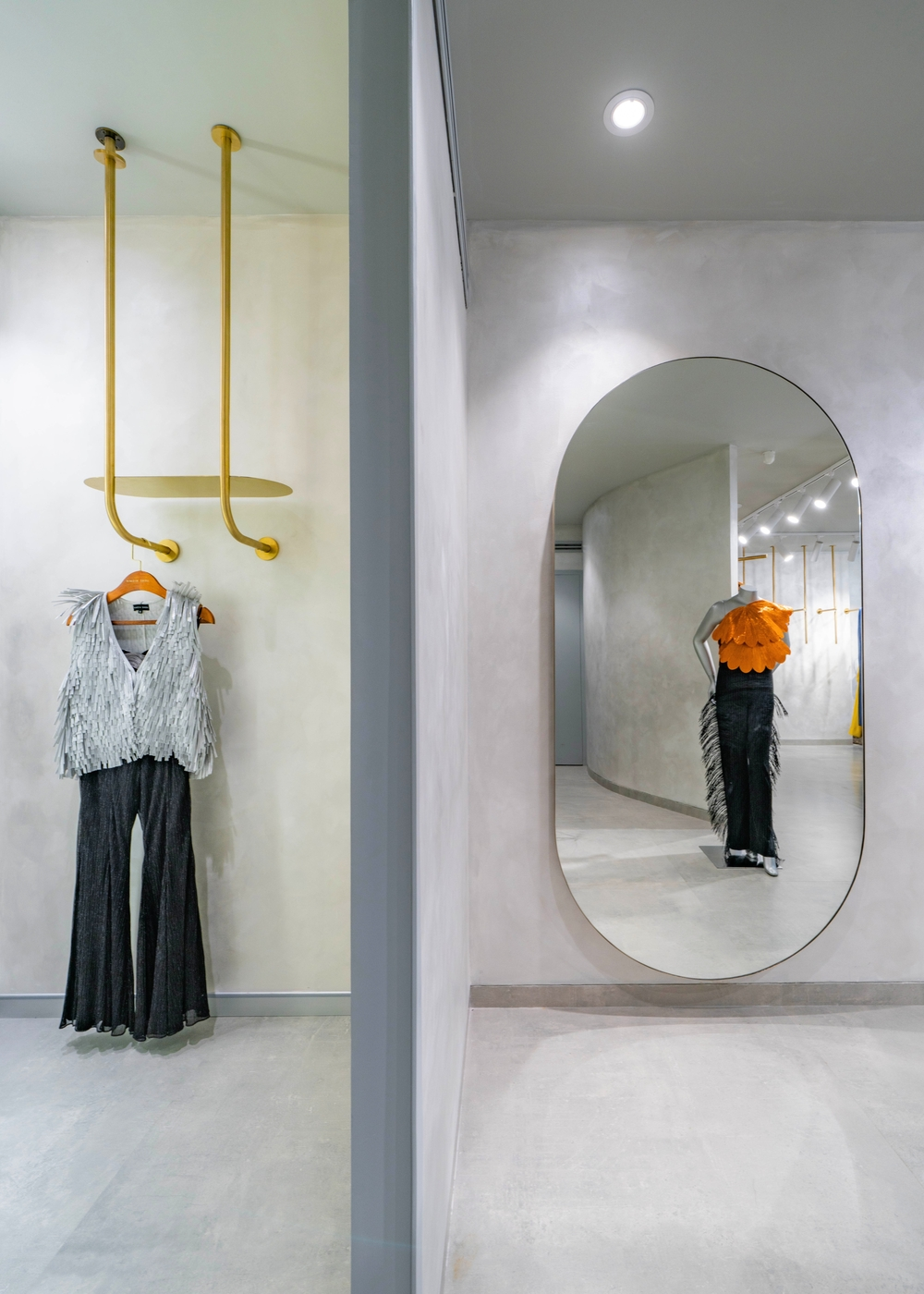(August 18, 2025) From Delhi’s narrow lanes to the red carpet at Cannes, and from India’s traditional looms to the galleries of London’s Victoria & Albert Museum, Rimzim Dadu has carried the spirit of Indian craft across the world. Her steel sari, worn by Sonam Kapoor at Cannes, turned the age-old drape into a modern sculpture, while her leather-cord patola skirt found a place at the V&A—two milestones that signalled her arrival on the global stage. Over the past 15 years, the 38-year-old has become a quiet but powerful voice in Indian design—one who doesn’t chase trends but reshapes them from the inside out.
In a world where fashion is often fleeting, her work feels like permanence: sculptural, elemental, timeless. She isn’t just dressing people; she’s bending metal into fluidity, turning tradition into rebellion, and proving that textiles can be as emotive as they are engineered. From Zendaya to Deepika Padukone, her creations have been worn by stars across continents, each piece carrying a story of reinvention, experimentation, and a fierce dedication to craft.

Rimzim Dadu
Her signature lies in transforming unconventional materials like steel, leather cords, and silicone into high fashion. But to truly understand her impact, one must first understand her journey, one marked by reinvention, experimentation, and a unique dedication to craft.
Finding her design palette
Born and raised in a Marwari business family in Delhi, where tradition and enterprise coexisted, Rimzim Dadu grew up surrounded by the hum of sewing machines and the scent of fresh fabric. Her family ran a small export house, DeeMan International, making clothes for European, Japanese, and American markets for over 25 years. The factory, once tucked into the basement of their home, became her playground—after school, she would wander down to watch tailors cut, sew, and embroider, mesmerised by the transformation of raw fabric into finished garments.
Her father, a creative force in his own right, took her along to international trade shows like Prêt-à-Porter in Paris, Premier Vision, Hong Kong Fashion Week, and WWD Magic in Las Vegas. They explored boutiques and offbeat flea markets across the world—Melrose Trading Post in L.A. remains a shared favourite. Those trips seeded a curiosity that was global in scope yet rooted in Indian craft.
View this post on Instagram
When she enrolled at Pearl Academy of Fashion in New Delhi, her unconventional approach to textiles began to emerge. Even as a student, she was more drawn to manipulating materials than sketching silhouettes, an early sign of the path she would carve. In 2007, at just 21, she launched her eponymous label. But success didn’t come easily—the early years were creatively rich but financially and emotionally taxing. In 2011, she took the unusual step of pausing her label.
“Time has brought clarity in voice, vision, and values,” she tells Global Indian. “I’ve moved from playful experimentation to thoughtful innovation. In my earlier years, it was about discovering new materials. Now, it’s about pushing those discoveries into deeper storytelling.” Her hiatus became her catalyst. By the time she relaunched her label in 2014, Rimzim had found her voice: a sculptural, minimal, and fiercely original aesthetic that would go on to redefine how Indian fashion thought about textiles.
The textile as the muse
What sets Dadu apart is her view of fabric not as something to be adorned, but as a material to be moulded. Her experiments with steel filaments, leather cords, and silicone push the boundaries of traditional garment construction, often beginning with Indian weaves or silhouettes before transforming them into something utterly new.
She reinvented the ubiquitous sari, introducing a metallic version that is a culmination of science and art. “Innovative materials like steel challenge everything we know about garment construction,” she explains. “They require patience, engineering, and most importantly, imagination.”
View this post on Instagram
Her iconic metallic sari crafted from hand-treated steel filaments; it shimmered like liquid metal but draped with the fluidity of chiffon. She states, “It took months of refining the technique, but the result was transformative. A perfect blend of industrial strength and feminine fluidity.”
When Sonam Kapoor wore it at Cannes, it wasn’t just a celebrity fashion moment—it was a statement that the sari, India’s most recognisable garment, could evolve without losing its soul. But for Dadu, it was less about the moment and more about the message that Indian garments, no matter how traditional, are open to individual interpretation. She explains, “The sari is timeless, yet endlessly adaptable. Reimagining it with new-age materials allows us to celebrate its legacy while pushing its boundaries.”
Similarly, her patola skirt reimagined the centuries-old double ikat weave of Gujarat using leather cords. Showcased at the Victoria & Albert Museum in London, it stood as proof that heritage crafts could converse fluently with modern materials.
Sculpting a store
Her design philosophy extends beyond the garment. When Dadu opened her second flagship in Hyderabad—her first outside of Delhi—it was a space that echoed her brand’s quiet strength.
“Hyderabad has always held a special place for us,” she says. “It’s a city steeped in culture, craft, and heritage values that lie at the heart of our brand. Over the years, many of our clients from Hyderabad would travel to Delhi just to shop with us. So, this felt like an organic progression, like coming home to a place that already understood and appreciated our language of design.”

The store was designed with the same tactile minimalism as her garments. She explains, “We created a space that is stripped of excess, where raw textures meet refined forms. Every element, from the muted stone finishes to the custom furniture upholstered in our signature textiles, is meant to elevate rather than compete with the garments. It is a quiet space that allows the clothing to resonate as wearable art.”
The visual and emotional centerpiece of the store? The sari wall.
“The sari wall is more than a display. It is a celebration,” Dadu says with visible pride. “It holds our most iconic drapes, each one pushing the boundaries of what a sari can be. From sculpted metallic textures to avant-garde silhouettes, the wall is designed to invite discovery. It allows visitors to see the sari not just as a garment, but as a living canvas of innovation.”
Fashion as a dialogue between craft and tech
What truly sets Dadu apart is her ability to work at the intersection of craft and technology, where tradition meets rebellion. Her groundbreaking patola skirt, created with leather cords, was showcased at the V&A Museum in London and remains one of her proudest innovations.
View this post on Instagram
“I’m fascinated by the tension between craft and technology, softness and structure,” she says. “That space in-between is where magic happens. The patola skirt exemplifies that; it’s where heritage weaving meets raw edge. I draw inspiration from architecture, sculpture, and even industrial design. My goal has always been to elevate fashion beyond clothing and to create pieces that spark emotion and dialogue.”
Carrying Brand India Forward
Though best known for her womenswear, Dadu has also made strides in menswear, an extension that’s been subtle yet impactful. She says, “Menswear demands a more architectural approach. Cleaner lines, subtler textures. It’s a more restrained canvas, but equally exciting.” The larger Hyderabad space has allowed her to present both sides of the brand in harmony.
Even as her collections expand, the core remains unchanged: a singular commitment to process, material innovation, and storytelling.
Every piece she creates is a conversation between India’s rich craft heritage and the possibilities of the future. For Dadu, the sari in steel or the patola in leather isn’t about replacing tradition—it’s about showing the world that Indian design is fearless enough to reimagine itself.
Staying true to herself
After 15 years in the business, one might assume the challenges would ease. But for Dadu, the bar only rises.

“The challenge now is to continue innovating while staying true to our voice,” she says. “What excites me is the idea of storytelling through space, material, and silhouette, whether it’s a garment or an immersive store like this. Every new project is a new chapter in that ongoing narrative.”
Indeed, the next chapter is already being sketched. She is exploring expansion both in India and globally, not just through retail, but also through immersive experiences and art-led installations.
“We’re excited to deepen our presence across India and internationally: not just through retail but through collaborations, installations, and perhaps even interiors,” she hints. “The idea is to build a universe that is textile-led, experimental, and unapologetically bold.”
A new grammar for Indian fashion
Rimzim Dadu’s work doesn’t fit neatly into any box, and that’s precisely the point. She isn’t trying to be ‘contemporary Indian’ or ‘futuristic global.’ She is simply building her own language where a sari can be made of steel, a wall can speak the story of a weave, and tradition doesn’t have to look backward.
- Follow Rimzim Dadu on Instagram
ALSO READ | NY to India Couture Week: How Aisha Rao built a global label rooted in Indian craft



